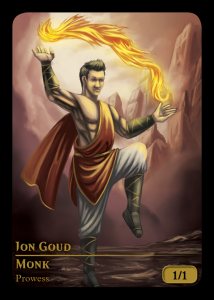Contents
Introduction

The first six months of 2018 have been quite a whirlwind for Canadian judges. Despite a tumultuous beginning to the year, at home and abroad, we’ve persevered and, I daresay, we’re a stronger, tighter community as a result. We’ve added some awesome judges to the Canadian family, and we’ve lost some poor souls to the frozen tundra of life-beyond-judging. This Mid-Year Checkpoint represents the first of our quarterly newsletters. And yes, I realize Mid-Year represents two quarters! But that’s alright, because that means this launch edition will feature double-double the Canadian goodness.
Angus has been the epitome of flexibility and passion this year. He’s approached every task with gusto, come up with and started sub-projects on his own (since amalgamated under the Hype Banner), and he graciously jumped teams when we had some unexpected vacancies, immediately producing content and ideating to fill the void.
Cali has spent more than a year and a half grinding against the forces that be called conglomerate branding. She is the unstoppable force up against a massive, immovable object, and because of that, we keep making progress. In fact, Cali’s efforts are the seed from which sprang the fruit of the Hype Team, so when you’re all decked out in Canadian SWAG by the end of this year, it’ll be Cali you have to thank!
Jeff leapt into action and took on a role as a Team Lead on incredibly short notice, and he has done so with tact, diligence, and wisdom. He’s leading our social media efforts, coordinating a team that ALSO added 2 new members when he joined up, and doing a damn fine job. It takes discipline, focus, as well as insight into the Canadian Judge and Magic communities in order to make a social media presence function as he has so far.
Jovy is the picture of consistency. His love for the Magic community is infectious, and he’s always looking for opportunities to contribute to Hype generation, in between his extensive, expert work on various Facebook rules pages. He’s been a willing participant in the fluctuating missions of the Coverage team this year, and he’s gone out of his way to make guides for new sets, image templates, and other varied forms of media to bring accessible insight into the obtuse game rules for players and judges alike.
That’s enough introductions for now. On with the show!
The New Docs – M19
The documents
There were no earth-shattering changes to the rules, IPG, or MTR in the most recent updates, but some adjustments were still made. Squee can now be bound by Ixalan, copy effects were cleaned up, and face-down permanents can now have copiable characteristics that differ from the blank 2/2 we know and love. In the world of policy documents, loops and missed triggers were tweaked, a new partial fix was added, and language was added to the draft procedure to make drafting M19 work.
Rules
Metamorphic Alteration is the first card in Magic history to create a copy effect as a static ability rather than a one-shot effect. This rules update clarifies that that static ability locks in the creature’s copiable characteristics as it first starts to apply rather than changing with the creature.
Tezzeret, Cruel Machinist allows cards to be put onto the battlefield face-down as 5/5 artifact creatures. As of this update, nothing in the Comprehensive Rules disagrees with the fact that any copies made of those permanents will also be 5/5 artifact creatures – a blank 2/2 is now simply the default rather than the only way for a face-down card to be.
Policy
The MTR now has a section about loops which supersedes the CR in a tournament setting. Loops spanning multiple turns are explicitly called out. The rules surrounding these are particularly relevant in the Standard-legal scenario where both players have an empty library, a Teferi, Hero of Dominaria, and the intent to draw Teferi, cast Teferi, tuck Teferi and pass the turn indefinitely. Spoilers: it’s a draw! Provided neither of them chooses to break that loop, of course. We’re also given the freedom to identify loops even if there are irrelevant things changing.
Bomat Courier’s attack trigger is no longer detrimental! We now look at a trigger in the context of the overall card, not the trigger in a vacuum, to see if it’s detrimental or not. Game state is still not a factor in this determination.
We have a new GRV partial fix! If a player forgot to untap something at the start of their turn, and it’s still the same turn, it can just be untapped. Remember to evaluate the situation for out of order sequencing before issuing a GRV though.
If draftable cards are present in some of the basic land slots in a set (such as M19), nothing occupying that slot in a pack gets removed, ensuring that everyone drafts with packs of the same size. This includes basic lands and checklist cards that would be removed from the pack in other draft formats.
Notable Cards and Interactions
To celebrate the release of M19, we’ve gone through the set and picked out some of the more unique cards. From a reset button for Two-Headed Giant to a brand-new flavour of copy effect, Core Set 2019 is bringing some neat rules interactions to a table near you!
Fraying Omnipotence
Ajani’s Pridemate
Isareth the Awakener, Skyrider Patrol, Sparktongue Dragon and Vivien’s Invocation
Alpine Moon
Leonin Warleader
Metamorphic Alteration
Have you noticed any other particularly neat rules interactions with cards from M19? Picked a card as frontrunner for causing the most judge calls? Tweet at us!
Promotions and New Certifications
New Blood
(Current as of June 30, 2018)
BC
Derek Schofield
Taiki Takeuchi
Nathan Lipetz
Alberta
Levi Ward
Joshua Stapleton
Parker Connors
Christopher Lancaster
Patrick Chateau
Brandon Scyner
Ontario
Fingal Letki
Nicola Mucciante
Jordan Raposo
John Welling
Aaron Orians
Dave Pascutto
Kyle Beck
Shawn Koroscil
Liam Clough
Joachim Wessmark
Quebec
Kevin Rocheleau
Antoine Guay-Molnar
Nova Scotia
Aaron O’Connor
Other
Morgan Roosenmaallen
Rafael Hanna
Levi Ward
Did we miss someone? You can submit certifications here to ensure they’re included in the next newsletter!
L2 Promotions
Stephen Tran
Why did you become a judge?My road to certification was a culmination of a few different factors. Talking to judges that were working events I was playing at introduced me to the program, and scoring well on old practice tests gave me the confidence to follow up. Seeing areas for improvement in my local community made me want to make a difference, and finally, having a local L2 to mentor and test me is what finally made me take the plunge.
What made you want to work towards Level 2?
I had actually planned on staying at L1 when I first certified, but soon after I did, I went on a spontaneous weekend trip to the east coast for a judge conference during which I spent time speaking to and gathering insight from L2s and my now-RC. It planted the seeds to advancement and from there, I started finding excuses to pursue L2, such as finding that my area could use more PPTQ support. I also felt that levelling up was a good way to validate my skills–to myself, other judges, my local community, and store owners.
What is your favourite Magic card?
An impossible question, but it has to be Lightning Bolt–I have a collection in the range of 400-450 copies. Runners up are Isamaru, Gifts Ungiven, Wander in Death, and Eternal Witness.
What is your favourite food?
Potatoes and eggs get a ton of respect for their sheer versatility, but lately I’ve been on a fried chicken kick.
Tell us something interesting about you!
I had a Whopper every Wednesday for a full year from August 2012 to August 2013.
Any advice for someone looking to advance to Level 2?
Anyone considering L2 should already be getting a lot of good advice from their peers, mentors, and RC, so I’ll try not to echo any of that. But something I discovered during my advancement was how useful tournament reports were. I read through a few to get a sense of how to write my own, but getting to hear a judge’s internal monologue about how they handled each call, how they could have improved throughout the day, their preparation, and their judging process in general really opened my eyes to what made for a good judge. That’s not to say that reading reports replaces live interaction with other judges, but they provide perspectives that aren’t often highlighted, so I’d recommend prospective L2s to read as many as they can.
Elliot Fortier
Why did you become a judge?I was in a position where I was very visible in my community, I was an admin in our city’s Magic Facebook group, and people knew me to be rules savvy since I had a lot of experience playing at competitive REL. When I went to play local magic the tournaments would either have nobody there with a judge level, or a TO who had been an L1 for a long time, but who wasn’t always available in the play area. Players would typically just ask me rules questions anyway, and I figured it made sense to seek out certification to make sure I had the philosophy right to make sure I was never leading anyone astray at FNM.
What made you want to work towards Level 2?
It was actually just a bit of coincidence. I went to a PPTQ after already qualifying just to hang out with my friends, and offered to lend a hand to the judge to do deck checks since there was a pretty large turnout. Deck checks turned into helping judge for the whole tournament, and I got some good feedback. At that point all I had left to do was the paperwork of submitting reviews and the tournament report before I could start thinking about the written test. With a mix of words of encouragement and pleading for me to get L2 to judge some local PPTQs from Jason Wong, I decided to go for it.
What is your favourite Magic card?
My brain screamed Siege Rhino at me when I read this question, so I guess that’s my final answer. I started playing Magic during THS-KTK standard and cast a lot of Siege Rhinos right off the bat.
What is your favourite food?
I’m a huge fan of things like tonkatsu or schnitzel. Meat that has been breaded and fried? That’s just a combo.
Tell us something interesting about you!
My first experience judging at competitive REL was head judging a PPTQ as an L1 as a pinch hitter after the L2 didn’t show up. This was actually before helping judge the PPTQ I mentioned earlier, and was really what set me up to become an L2 later on.
Any advice for someone looking to advance to Level 2?
My biggest piece of advice is to play as much at competitive REL as possible. In all my experience both interacting as a judge as a player and as a peer is that there is pretty often a disconnect between mentality of a competitive player, and what judges think the mentality of a competitive player is. As a judge the majority of what you do is going to be following the letter of the law, but every tournament there will be a handful of opportunities where you’re for example, choosing whether or not to downgrade a penalty, and I think that the experience of having been in every position, the person receiving the penalty, their opponent, and as a judge, you will more often make the best decision that certainly serves to maintain the integrity of the tournament, but more importantly ensures that nobody is leaving with a bad taste in their mouth, which in the long run will, I believe, make you a better judge. In terms of short term benefits, I’ve found the rules that stick with me most are those I’ve learned while playing magic, not just by reading the MTR.
Kaitlin McLachlan
Why did you become a judge?I was frustrated with my local area and started backing away from Magic. The very few GPs and large events I had gone to had left me feeling unwelcome and harshly judged for being a woman. My friend and local Toronto rockstar, Graham Schofield approached me with the idea of being a judge, giving me a way to channel my frustration and combine it with my passion for the game to make Magic a better place.
What made you want to work towards Level 2?
I think in big part the lack of female representation in Canada. It’s a large region without a lot of female level 1 judges let alone level 2. I knew I loved judging and wanted to push to the next level to grant myself more opportunities and to be a little more visible to female players looking to be a judge!
What is your favourite Magic card?
Guttersnipe.
What is your favourite food?
Cheesecake.
Tell us something interesting about you!
I had traveled to 12 countries before the age of 14 but hadn’t left Ontario since then until GP Vegas last year!
Any advice for someone looking to advance to Level 2?
My path to L2 was a rapid and exciting, yet exhausting one. I set a goal and worked really hard to get there, not taking the time to breathe or really figure out if my goal was realistic. I spent a lot of money travelling and many weekends far from home. Pace yourself, it isn’t a race. The opportunities will be there, make sure that you’re taking care of yourself. It’s easy to get caught up in the excitement but that path can be physically, emotionally and financially exhausting.
The other huge thing I learned is to use the resources you have. Every judge you meet will teach you something new, figure out what their strengths are and allow yourself to learn from them!
Maxime Émond
Why did you become a judge?Funny story: I have always wanted to be a judge. But life being life, I never had the time to dedicate to it until very recently, where I started my “judging career.” The biggest reason for my interest was to help develop the community and try to help players to better understand every actor’s point of view in our beloved game.
What is your favourite Magic Card?
Lightning Bolt. Keep calm and burn things.
What is your favourite food?
Sushi/sea food! I feel like there is nothing better than some sea food!
Tell us something interesting about you!
Interesting? Huh. I have been playing Magic since elementary school. I did play with dual lands without sleeves on cement (which I totally regret!). Now, I have become very interested in the lore of the game.
I also at one point was a semi-pro player in Starcraft II: Heart of the Swarm. When I stopped, I was ranked in the Master Division and did play a few big names on the ranked ladder, including Idra, MVP, and MarineKingPrime.
L2 Tester and Team Lead Certification
Mike Gyssels
Why did you become a judge?I became a judge because I wanted to be an ambassador for the game. I loved teaching my students how to play at school, and I wanted to use that experience to help build my local community.
What is your favourite Magic card?
Everyone who has ever played a game of Magic against me knows the answer to the question: Mystical Teachings!
What is your favourite food?
This is tricky because I’ve recently made some dietary changes, so I guess I’d say black bean burgers?
What made you want to work towards your Day 2 Team Lead ?
The Day 2 TL is a L3 checklist item–so, I guess, surprise everyone: I have started working on that. More than that, though, I saw the TLC as a chance for me to flex those teaching and leadership skills I mentioned above, but at a more challenging and advanced level. Likewise, I saw it as an opportunity to put myself out there a little bit: I wanted to learn to work with judges more experienced and way smarter than me, to try and glean as much as I could from them.
What was the skill that you think is most overlooked when preparing for day 2 team lead tests?
Delegation. Delegation. Delegation. It’s front and centre on the list of skills (seriously, there’s a whole rubric you should read and know and evaluate yourself against!), yet when you’re put into that leadership role for the first time, it’s easy to get sucked in to overdoing it. People fear the worst–that jobs won’t get done, or something catastrophic will happen–so they often micromanage way too much and struggle to let go of the reigns on various tasks. It’s important to trust your team and let them take care of most of the tasks. Your job is to lead, which means being available to approve backups, provide consultation on tricky calls, or take notes for feedback. All of those tasks require that you’re not bogged down in the nitty gritty of the team tasks.
What about the Level 2 Tester?
Well, obviously I’m trying to assemble the Infinity Stones… Seriously, though: it gets said all the time that “Canada is huge!” and there are so many judges in my area on the path to leveling up. I want to close that distance for them. They might not get accepted to a GP for some time or they can’t travel to Kingston (or elsewhere), but they still need support. In short, the GTA (and the LTA, as I like to call it) have a lot of Magic players and strong Magic communities, and those communities need good judges. As our local vets like Rick Miles, Graham Schofield, and to some extent, myself, spend more time travelling the GP circuit, there are going to be PPTQs looking for judges and L0s looking for mentors. I’m currently working with a group of 10+ L0s (though a few have graduated!) because we’re short on L2s west of the CN Tower. I hope that I can use the experience I’ve gained as a GP judge, as well as my position as a leader in the community to help level up the next generation of L2s who will carry on the work we’ve been doing.
Tell us something interesting about you!
I can peel a banana with my feet.
Regional Projects
Written by Mike Gyssels
On Canada Day this year, we debuted a number of hype team initiatives. This sections talks a little bit about the impetus behind those projects, plans for those projects and others, and some reflection on project success.
Feedback Form Tokens
The first 2/5 Canadian Feedback tokens were shipped out to everyone who volunteered to host a Cross-Canada Day event this year. These tokens feature Jon and Jason, two of our L3s, done up as their favourite creature types (monk and homunculus, respectively). We love the feedback form initiative in all its various iterations, and so we had the team work to produce a token unique to our region that could be given out specially by our judge and to our players.
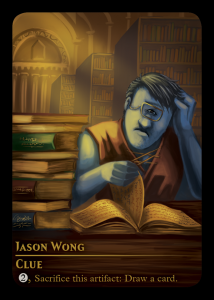
Because of that regional focus, I modified the token back from other versions you may have seen. These tokens also feature information on joining the program, to extend an olive branch to those players who might want to join our big happy family. And that brings us to the faces on the front: I’ve said it, Jon’s said it, Kenny’s said–our region is huge. Our L3s are regional leaders, but we don’t always have the pleasure and good fortune to work closely with them. As such, I wanted these tokens to develop some connective tissue between our players, our judges, our cities and provinces that make up a wonderful Magic Community, to make Canada feel just a little bit more whole.
It’s my hope that when players and future judges see the faces on the tokens–in person or online–that they’ll feel just a little bit more excited, a little bit more comfortable, knowing they’re in good hands at a given tournament.
Going forward, you’ll see 3 more tokens by Vancouver (perhaps sooner). There are currently no formal plans to expand beyond these 5 artworks–yet. But, I never sleep and spend most of my free time dreaming of judge projects, so who knows what the future holds!
A special thanks to Tobias Vyseri for her artwork. She has been a dream to work with and her enthusiasm for the project helped me get it put together in a fairly short time frame.
ResultSlip Canada
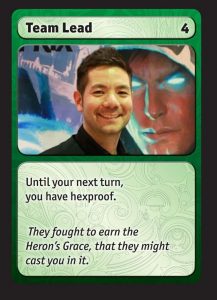 As has been noted elsewhere, we put together a special version of ResultSlip for Nationals. If you haven’t been to a large-scale (GP) event as a judge, you may not be familiar with the project, but details are available on Apps. In short, the project puts together a couple versions of the game with friendly faces from the event’s staff. Often the “Team Lead” card is occupied by someone testing for TLC, for example. I know that when I was in that position, I was excited–and actually somewhat calmed–to see my face on the cards and to be recognized in a small way by my community.
As has been noted elsewhere, we put together a special version of ResultSlip for Nationals. If you haven’t been to a large-scale (GP) event as a judge, you may not be familiar with the project, but details are available on Apps. In short, the project puts together a couple versions of the game with friendly faces from the event’s staff. Often the “Team Lead” card is occupied by someone testing for TLC, for example. I know that when I was in that position, I was excited–and actually somewhat calmed–to see my face on the cards and to be recognized in a small way by my community.
I wanted ResultSlip Canada to bring that same feeling to as many people as possible, especially folks who might not often get the chance to be included. In our case, I colour-coded the cards so that I could use a different judge on each card, instead of just one picture per role, while maintaining the easy and enjoyable game play. As a result, 16 of our judges, a mix of our most recognizable faces, GP Rock Stars, and up-and-comers, from as many provinces as possible (JudgeApps photos being a serious requirement) come together to create this version of the game. We worked hard to ensure that roles were representative of people in our region, so that folks could be recognized for all the great work they’re doing. Some might not be a perfect fit (sorry, Kenny!), but I’m confident that everyone who picks up a copy of the game will see some friendly faces while also learning something new about our region!
I want to thank Kevin Rocheleau who put together about 4,000 (okay, like 40) card design examples for me, and for the work he did translating Love Letter’s cards into Magic terminology. Likewise, thanks to Tobi for putting her flourish on the cards.
As for distribution, the size of the full deck and the cost of ordering has limited distribution somewhat, so I’ve sent copies to judge parties and will continue to do so until I run out. When we begin selling products online, you can expect to be able to order a version of this game! Likewise, at Canadian Events till the end of the year, it’s likely that HJs might end up with a few copies for distribution!
Canadian Judge Logo
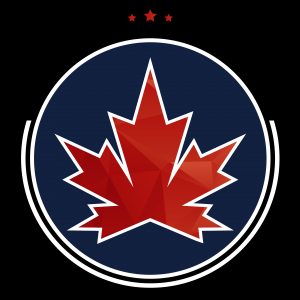 The logo has gone through many iterations as Wizards updated its branding–and subsequently its guidelines and expectations for us. The logo in its current iteration can be seen on the backs of ResultSlip Canada and the Feedback Form tokens.
The logo has gone through many iterations as Wizards updated its branding–and subsequently its guidelines and expectations for us. The logo in its current iteration can be seen on the backs of ResultSlip Canada and the Feedback Form tokens.
We’re very proud of the logo, which takes stylistic queues from the Planeswalker Spark and, of course, our trusty maple leaf. I’ve heard from more than a handful of folks that it looks “like a hockey team crest” and that was, on all accounts, intentional on the part of our design leadership. We wanted to capture the spirit of sports team loyalty and passion that so many folks feel. When wearing this logo, we want our judges to feel like they’re part of a huge team. We’re here to support one another, learn from one another, and ultimately, to have fun with one another, as part of this big team. We also wanted our crest to be simple, clean, recognizable, and flexible for a varied product array. We hope that you’ll soon be able to wear our logo and wear it with pride.
Events
Cross-Canada Day Judge Party Retrospective
Written by Sam Hung
This year we celebrated Canada Day by having Canadian Nationals during that weekend. Unfortunately, many of our judges couldn’t make it out to Nationals, so we brought the party to 6 other areas in Canada! The main goal was to make our vast country seem smaller and to make everyone feel like family. I want to give a special shout-out to the judges that took on a leadership role in making this happen, because without them it would not have been nearly as successful as it was.
- Peter Davies
- Mike Gyssels
- Chris Hrichishen
- Alex McGregor
- Trevor Murdock
- Dallas Nickel
- Aaron O’Connor

We ran a campaign, #ShowYourRed, to connect the community through Facebook and Twitter. We also had a Discord Channel where judges at these events were able to join the conversation and post pictures and videos of judges being judges. This event was well-received and brought us all closer in a way. We had drafts, beverages, fantastic EDH interactions, and lots of great fun at some outstanding venues. We also had the judges at Nationals join in on the fun by taking a picture at the booth and posting them onto the Facebook page with #ShowYourRed. Many excellent pictures came from that event!
As with every large event, there were bound to be a few hiccups. There were a few communication issues between myself and the rest of leads, but I have identified them and will take steps to prevent them in the next big event we have. One of the parties had a last-minute venue change, but the judges still made it over on time and ready to have some fun!
I am happy to be part of the Hype Team to bring you gatherings, parties, and other events that judges can attend. Stay tuned for the next big event coming soon.
Conferences
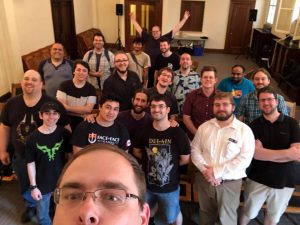
A whole lot of learning went on from January to June in Canada. Below, you’ll find a breakdown of all the great lessons your peers taught this year. We’re also updating the Conference Centre with downloadable versions of as many of these presentations as possible, but, if you want to know more, don’t hesitate to reach out to these folks!
Toronto
- Graham Schofield – Applying for Large Events
A detailed look at the event application process for judges looking to make the jump from local to area judging. Includes examples of cover letters from various events. - Kaitlin McLachlan – Using Policy to Create Inclusive Spaces
A powerful look at the culture of Magic events and the tools the IPG and MTR provide for us to shift that culture to be more inclusive for all of our players. - Jon Goud – Investigations
Role-playing and tips to quickly level up investigative skills–and strategies to continue growing those skills. - Duncan McGregor – Professionalism and Judging
A presentation that covers everything from online conduct and applications, to on-the-floor interactions, aimed at judges interested in branching out beyond local judging.
Vancouver
- Stephan Classen and Niko Skartvedt – The IPG and You
A game show-style quiz on the IPG using Kahoot, with follow-up discussions dedicated to the philosophy behind the answers. - Tobias Vyseri – How do I GP? A Beginner’s Guide
An introductory look at what it’s like judging your first GP, including applications, self-preparation, and judging in various roles. - Stephan Classen – Building Judge Communities: Ask what you can do for Judging
This presentation covers strategies for building connections among your local community and addresses some of the challenges that can inhibit community growth. - Frank Chafe – Deck Checks: Everything you Need to Know
A comprehensive guide to deck checks, including philosophy on why we do them and strategies for how to do them. - Niko Skartvedt – Investigations Role-Play
A workshop allowing judges to role-play either as players or call-takers to practice investigations skills in live situations. - David Poon – Recent Rules Changes
David broke down some new rules and policy updates, including that pesky planeswalker redirection / direct damage spell update.
Alberta
- Abeed Bendall – Hidden Card Error
An adaptation of Jona Bemindt’s presentation 404 Card Not Found, that covers the policy, philosophy, and additional remedies for Hidden Card Error. - Jon Wilson – From Kitchen Table to Competitive
This presentation looks at how we can create welcoming competitive spaces and convince casual players to come out and join our competitive tournaments. - Darren Gamble – Additional Remedies
An in-depth look at additional remedies for all relevant sections in the IPG. Especially useful for judges interested in testing for L2. - Jeff Orom – Investigations Workshop
4 scenarios designed for judges to practice their investigations skills; experienced judges were given the opportunity to role-play as players for newer judges to interact with. - Sam Hung – Head Judge Best Practices
Sam’s presentation covers the duties and responsibilities of Head Judge’s, including appeals, deviations, as well as team and logistics management.
Halifax
- Aaron O’Connor – Community Building for a Rogue Format
How to get players and TOs interested in and excited about previously unsupported formats in your local community. - Kenny Dolson – USC – Major/Minor
How to identify USC – Minor and USC – Major, and how to work through the call once you’ve identified the infraction. - Samantha Harr – Women in the Magic Community
Presenting a woman’s perspective from within the Magic community and ways other people can be helpful in an uncomfortable situation. - Benoit Seveno – How to Manage a Team
Benoit’s presentation provided some general team management tips as well as introducing different personalities, each corresponding to a different colour of mana, and how they interact with each other. - Jon Goud – Comp REL Workshop
A three-round mock tournament enforced at Competitive REL with secret “missions” for each player in each round ensuring L0s and L1s got plenty of experience with interesting calls.
Montreal
- Robert Hinrichsen – The Process of Casting a Spell
An in-depth intensive review of the process of casting a spell. - Chris McGuire – Slow Play
This presentation talks about what slow play is, why we’re supposed to enforce it (and why we’re not), and examines the MTR additions regarding loops. - Charles Trottier – Judge Leadership, Beyond Judging: Customer Service and Community Leaders
Group discussions about roles at tournaments, leadership, and how to approach situations that look like they don’t have a good or well-defined method of dealing with them. - Maxime Emond – Identifying Fake Cards
Tips and tricks for detecting counterfeit cards, as well as strategies for identification when you encounter suspicious cards. - Eric Pare – Investigations Workshop
Attendees participating in the investigations workshop get to observe scripted demonstrations of games taking place where problems occur and judges figure out solutions as if they were real games.
Events with Upcoming Application Deadlines
- Montreal FacetoFace 5K (August 11) – Apply by July 31
- Ottawa Judge Conference (October 21) – Apply by October 9
- Fusion Gaming 5K (October 26-28) – Apply by September 28
- GP Vancouver – TBA
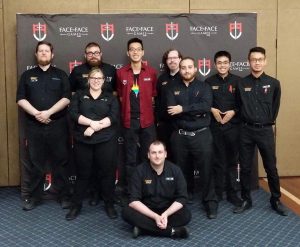

Quarter-in-Review
- Does your area need an L2 Tester? – When Jon Goud took over as our RC, the L2 Tester program began a pilot phase in earnest. The pilot phase is now over and, notably, Mike Gyssels was recently promoted to L2 Tester. If you think your area needs an L2 Tester, start by filling out this form.
- Road to L2 – The team has chosen authors for our list of suggested topics (found here). We’re looking forward to the first posting toward the end of July, and then periodically after that point. If you have an idea that isn’t covered here and would like to write that article, please email mikegyssels@gmail.com
- Wave 13’s Vanguard is here – By now, those of you who were recognized for your hard work during Wave 13 should have noticed a fancy new token, similar to the ‘Treasures’ included in Wave 12. These mark the launch of the Vanguard program. To learn more, go here!
- Canadian Regional Enrichment Sponsorship – The Canadian Regional Enrichment Sponsorship has started to produce some articles for your enjoyment, starting with David Lachance-Poitras’ report on judging a report PPTQ at his childhood LGS!
- Tobias Vyseri and the Value of the Tournament Report – Tobi received a CRES to travel to Vegas and, as has become an astonishing habit, produced an excellent tournament report. Seriously, check out the Tournament Reports forum on JudgeApps and you’re sure to learn something from such a prolific and insightful report writer.
- Canada has two official languages – So, from this point forward, we’ll be working hard to not only translate our back catalogue of blog posts, but also to offer future content in both English and French.
Conclusion
That’s it / C’est tout! Join us in October, following the release of Guilds of Ravnica (Yay, we’re going back–again!) for more. In the coming weeks, we’ve got some great articles, as well as some super special project announcements that I’m sure will have you all wrapped with excitement!
Until next time, spell slingers, keep your sticks/staffs/wands/spellbooks on the ice!
(Can I say that? Is it a trademark?)
Special thanks to our contributors, et aussi les traducteurs!
Contributors:
Jan de Vlaming
Kenny Dolson
Mike Gyssels
Mike Hill
Traducteurs:
TBA

